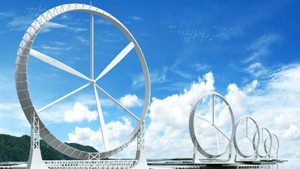19th January 2012
By Karl Burkart – mnn.com/green-tech
The International Clean Energy Analysis (ICEA) gateway estimates that the U.S. possesses 2.2 million km2 of high wind potential (Class 3-7 winds) — about 850,000 square miles of land that could yield high levels of wind energy. This makes the U.S. something of a Saudi Arabia for wind energy, ranked third in the world for total wind energy potential.
Let’s say we developed just 20 percent of those wind resources — 170,000 square miles (440,000 km2) or an area roughly 1/4 the size of Alaska — we could produce a whopping 8.7 billion megawatt hours of electricity each year (based on a theoretical conversion of six 1.5 MW turbines per km2 and an average output of 25 percent. (1.5 MW x 365 days x 24 hrs x 25% = 3,285 MWh’s).
The United States uses about 26.6 billion MWh’s, so at the above rate we could satisfy a full one-third of our total annual energy needs. (Of course, this assumes the concurrent deployment of a nationwide Smart Grid that could store and disburse the variable sources of wind power as needed using a variety of technologies — gas or coal peaking, utility scale storage via batteries or fly-wheels, etc).
Now what if a breakthrough came along that potentially tripled the energy output of those turbines? You see where I’m going. We could in theory supply the TOTAL annual energy needs of the U.S. simply by exploiting 20 percent of our available wind resources.
Well, such a breakthrough has been made, and it’s called the “wind lens.”
Imagine: no more dirty coal power, no more mining deaths, no more nuclear disasters, no more polluted aquifers as a result of fracking. Our entire society powered by the quiet “woosh” of a wind turbine. Kyushu University’s wind lens turbine is one example of the many innovations happening right now that could in the near future make this utopian vision a reality.
Yes, it’s a heck of a lot of wind turbines (about 2,640,000) but the U.S. with its endless miles of prairie and agricultural land is one of the few nations that could actually deploy such a network of wind turbines without disrupting the current productivity of the land (Russia and China also come to mind). It would also be a win-win for states in the highest wind area — the Midwest — which has been hard hit by the recession. And think of the millions upon millions of jobs that would be created building a 21st century energy distribution system free of the shackles of ever-diminishing fossil fuel supplies.
It’s also important to point out that growth in wind power capacity is perfectly symbiotic with projected growth in electric vehicles. EV battery packs can soak up wind power produced during the night, helping to equalize the curve of daytime energy demand. So the controversial investment currently being entertained by President Obama to pipe oil down from the Canadian Tar Sands would — in my utopian vision — be a moot point.
It is indeed a lofty vision, but the technology we need is now in our reach. And think of the benefits of having our power production fed by a resource that is both free and unlimited. One downside often cited by advocates of coal and gas power is that wind turbines require a lot more maintenance than a typical coal or gas power plant. But in a lagging economy this might just be wind power’s biggest upside — it will create lots and lots of permanent jobs, sparking a new cycle of economic growth in America.

If you've found value in our articles, we invite you to support the release of our brand-new book, "Gratitude Practices for Kids: A Practical Guide for Adults to Instill a Spirit of Appreciation and Positivity in the Next Generation."
"Gratitude Practices for Kids" brings together over 25 innovative and accessible practices designed to enhance gratitude in everyday life. This comprehensive guide is backed by 17 scientific studies, ensuring each concept is grounded in research, underscoring our commitment to nurturing growth, emotional intelligence, and positive interactions between adults and children.
We encourage you to opt for the paperback version to celebrate this new release. Dive into its fresh pages away from digital distractions, allowing you to immerse yourself in the transformative practices it offers.
Over recent years, Wake Up World has faced significant online censorship, which has impacted our financial ability to operate. Moving into book publishing represents a strategic step to secure the ongoing funds needed to continue our mission. By purchasing Gratitude for Kids, you help us keep our content free and accessible to everyone, avoiding needing a paywall. With over 8,500 articles published in the last 13 years, we remain dedicated to keeping our valuable content open to all.




